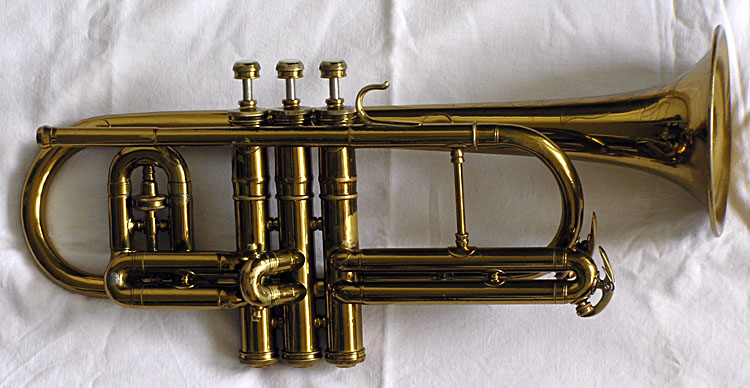Conn 38A Victor

Date: 1936, Owned by Christine Derksen.
This is the 38A Victor. It has bottom spring valves and has a #1½ (0.458") bore, which at the time was described as a "small" bore. The main tuning slide has an expanding bore: the top tube of the main tuning slide is 0.438" and the bottom tube is 0.458". The bell size is 4 5/8", and it was produced between 1936 and 1941. This particular 38A Victor is missing small knob on the first slide to pull the slide out with. The opera glass tuning slide knob is not original to this instrument but an almost perfect match. It also has some patches, a few small dents and was probably relacquered early in its life. After which at some point it probably fell to the floor mouthpiece first causing the mouthpiece to become stuck in the mouthpiece receiver and the leadpipe to be bent down. It was then presumably put in a cupboard and forgotten about for several decades, because when I got it most of the slides were stuck. The repair people managed to get the mouthpiece out, bend the leadpipe back into its proper position, get some of the dents out and un-stick the slides. It plays very nicely now.
Patent for this instrument was applied for on October 4, 1937, U.S. Patent number 2,146,967. Part of the patent application reads as follows: "An object of the invention is to shorten the instrument, without sacrificing any of the tone quality, by arranging the tuning slide in a complete loop, the ends of which are arranged beside each other and facing in opposite directions, instead of the U-shaped section in which the tuning slide is usually arranged, thereby adding to the length of the air column in the instrument the full width of the loop, and consequently permitting shortening the the length of the instrument somewhat for any given total length of the air column. This involves offsetting the parts of the instrument body at the base of the loop, [as explained below,] to bring them along side each other." The patent application then goes on to state the second purpose of the patent: "Another object of the invention is to speed up the adjustment of the tuning slide by utilizing and adjustment member (...) having right-and-left threaded engagement with posts mounted to extend towards across the loop from the tuning slide and from the instrument body." The upshot of all this is that as well as shortening the length of the instrument by the width of the opera glass tuning slide, turning the knob of the tuning slide will extend it twice as fast as on, for example, the 80A.
As for the tuning and the long or short shank mouthpiece (discussed in the following paragraphs), on this instrument I find that the modern long shank cornet mouthpiece does fit but not quite as snug as a short shank mouthpiece for which it was designed. It seems to me the short shank mouthpiece offers slightly less resistance, it "opens it up" a bit. Tuning with both the short and long shank mouthpieces is remarkably good on Eb, D and C#. Both the Eb and D are almost exactly in tune, the C# is a bit sharp (of course).
I have learned that the third slide without the finger ring to adjust the pitch of a low D and C# is slightly longer than it is on modern instruments. On modern instruments the low Eb is in tune, but the low D and C# are quite sharp. On these older cornets with the longer third slide and no finger ring the Eb is a bit flat and the D and C# are slightly sharp, but not as sharp as they are on later instruments. It was thought that the flat Eb and slightly sharp D and C# were within the abilities of the player to lip into tune.
All Conn cornets built before 1955 take a short shank cornet mouthpiece as opposed to the 2¾" "Bach-style" long shank cornet mouthpiece. For a discussion on the subject, please see The short and long of cornet mouthpieces.
What Conn said in 1937:
The new 38A Victor cornet was developed to meet the insistent demand for a cornet similar to the famous 80A Victor
but in smaller bore. Soloists especially demanded a cornet which would make their work easier in the upper register.
To make a cornet in small bore with both a good upper register and also a good lower register presented a most
difficult task. But Conn engineers, after nearly two years of experimenting, have produced just such a cornet.
The angle of taper in the bore of this cornet is greater than in any other Conn cornet. It widens from a small mouthpipe
to an unusually large throated bell. This design gives a very flexible scale and a rich, mellow tone. The upper register
is true and pure, while the lower notes are solid and full. This is unusual in a small bore cornet, for generally if the
upper register is good the lower register is windy, colorless and hard to get. Although free blowing, it has proper
resistance which gives the player just the "feel" he wants. Being in small bore, the stroke of the pistons is shortened,
giving a short, fast action. Some of the finest cornet soloists in America helped us develop this model and their tests
of the final model are enthusiastic in its praise. One of the first to purchase was the famous Ernest Williams, Ernest
Williams School of Music. Key of Bb and A. Tuning wheel. Clickless Crysteel valves. Finger hook.